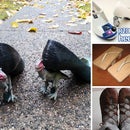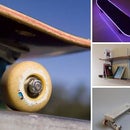Introduction: 3D Printed Skateboard Wheels
Working [hard] at Instructables means I have access to a ton of equipment, such as laser cutters, water jets, and 3D printers. Recently, I've been intrigued by the fleet of 3D printers we have sitting in Pier 9. Knowing that I have access to the printers and materials, I asked myself a question that has probably been asked millions of times: "What should I make?"
On my free time, I've been skateboarding around the beautiful city of San Francisco. But, there is a downside to this. More skateboarding means more accumulative damage to my skateboard; the trucks, the deck, the bearings, and the wheels. To my knowledge, we can't 3D print with metals at Pier 9 [yet], so printing skateboard trucks are out of the question, even though titanium skateboard trucks would be badass. What about the skateboard deck itself? I don't enjoy having to pay $45.99 (before taxes and excluding griptape) for a new deck every time I need a new one, but it's an essential. I could just make one with a vacuum cleaner if I wanted to, but I support Toy Machine all day, everyday.
So, what's left? Hardware and bearings aren't too expensive, so let's cancel those out, too. That leaves us with the wheels. Skateboard wheels are most commonly known to be made with polyurethane, which unfortunately is not an available material that we can 3D print with. If I could 3D print with polyurethane, I would be the proud CEO of many polyurethane based business, and I'd be wearing suits all the time. Tuxedos as well, but less frequently.
After messing around a bit with 123D Design (thanks to Artist in Residence M.C. Langer for teaching me!), I whipped up a couple of models and started taking them to the 3D printers. Feel free to use the included .stl files as guidance if you plan on making your own wheels of a different size.
All wheels were printed with VeroWhite & Tango+, switching around with different density levels for stronger or softer wheels.
Test #1 - 52mm cruiser wheels, 53mm regular wheels
The width of the wheels wasn't wide enough, and the inner radius was a bit too small. I had to use a Dremel to widen the inner diameter about x1.5 the size.
The cruiser wheels (52mm) didn't hold up too well, having somewhat of a flex to them. As soon as pressure is applied to the top of the skateboard, the wheels would squish down, blocking the bearing from spinning properly. The regular wheels (53mm) did well, unfortunately flatspotting a bit easily. These were a bit too soft still, so in the next test I will be choosing a denser setting.
Test #2 - 52mm cruiser wheels, 53mm regular wheels
The regular wheels (53mm) were awesome; PP-like material, all white (with no transparency!), no flatspotting (well, 95% of the time), impact doesn't damage the wheel at all Only downside: too slippery. I'll be adding grip in the next set of wheels. The cruiser wheels were great; strong with no flex. Still just a wee-bit too soft, so I think for future wheels I feel be using the same density level as these 53mm wheels.
Test #3 - 54mm regular wheels + ridges with .1mm & .2mm spacing
Some skateboard wheels have lines all around the circumference of the wheel for grip. You can see what I'm talking about in this image. New to 123D Design and 3D modeling software in general, I wasn't sure if there was an easier way to add these lines, almost like threads on a screw, so I set out to space them out manually. Let's call this method "Mikey's Way".
Both wheels did awesome as expected. The grip worked great at first, but after about an hour or so of skating, dirt and other gross things of the tough thug San Francisco streets started to accumulate on the wheel, making the grip worthless and unnoticeable while skateboarding. The wheels then again became slippery like the previous set, but only on certain surfaces; mostly tile or smooth brick. The .1mm spaced out wheels are still holding up fine (I'm actually writing this as I'm skateboarding on them to the grocery store), but if you look at the photos above, you'll see what happened to the thinner 54mm wheel (with .2mm spacing).
I also happened to be testing the wheels out on Gregg's (aka frenzy) Keyboard Skateboard the previous night going down Market St. in Downtown San Francisco. I guess you could say this was my [failed] attempt of "breaking them in". The sidewalk of Market Street is unfortunately made up by uneven (but somewhat smooth) brick tile, as shown here, which is also set up in a strange diagonal pattern. Therefore, when skateboarding down Market Street, I have a bit of trouble going as fast as I'd like to because the cracks in the brick tend to slow you down. If the bricks were lined up straight with the direction I'm headed and evenly leveled out, I'd be zipping down that street faster than the star power-up you get in Super Mario Kart when you're trying to beat your best lap on Moo Moo Farm. Yes, that's right, faster than that. I suspect the cracks in the bricks may have weakened the wheels quicker than they would've during normal use, but there's only one way to find out: print more wheels!
On my free time, I've been skateboarding around the beautiful city of San Francisco. But, there is a downside to this. More skateboarding means more accumulative damage to my skateboard; the trucks, the deck, the bearings, and the wheels. To my knowledge, we can't 3D print with metals at Pier 9 [yet], so printing skateboard trucks are out of the question, even though titanium skateboard trucks would be badass. What about the skateboard deck itself? I don't enjoy having to pay $45.99 (before taxes and excluding griptape) for a new deck every time I need a new one, but it's an essential. I could just make one with a vacuum cleaner if I wanted to, but I support Toy Machine all day, everyday.
So, what's left? Hardware and bearings aren't too expensive, so let's cancel those out, too. That leaves us with the wheels. Skateboard wheels are most commonly known to be made with polyurethane, which unfortunately is not an available material that we can 3D print with. If I could 3D print with polyurethane, I would be the proud CEO of many polyurethane based business, and I'd be wearing suits all the time. Tuxedos as well, but less frequently.
After messing around a bit with 123D Design (thanks to Artist in Residence M.C. Langer for teaching me!), I whipped up a couple of models and started taking them to the 3D printers. Feel free to use the included .stl files as guidance if you plan on making your own wheels of a different size.
All wheels were printed with VeroWhite & Tango+, switching around with different density levels for stronger or softer wheels.
Test #1 - 52mm cruiser wheels, 53mm regular wheels
The width of the wheels wasn't wide enough, and the inner radius was a bit too small. I had to use a Dremel to widen the inner diameter about x1.5 the size.
The cruiser wheels (52mm) didn't hold up too well, having somewhat of a flex to them. As soon as pressure is applied to the top of the skateboard, the wheels would squish down, blocking the bearing from spinning properly. The regular wheels (53mm) did well, unfortunately flatspotting a bit easily. These were a bit too soft still, so in the next test I will be choosing a denser setting.
Test #2 - 52mm cruiser wheels, 53mm regular wheels
The regular wheels (53mm) were awesome; PP-like material, all white (with no transparency!), no flatspotting (well, 95% of the time), impact doesn't damage the wheel at all Only downside: too slippery. I'll be adding grip in the next set of wheels. The cruiser wheels were great; strong with no flex. Still just a wee-bit too soft, so I think for future wheels I feel be using the same density level as these 53mm wheels.
Test #3 - 54mm regular wheels + ridges with .1mm & .2mm spacing
Some skateboard wheels have lines all around the circumference of the wheel for grip. You can see what I'm talking about in this image. New to 123D Design and 3D modeling software in general, I wasn't sure if there was an easier way to add these lines, almost like threads on a screw, so I set out to space them out manually. Let's call this method "Mikey's Way".
Both wheels did awesome as expected. The grip worked great at first, but after about an hour or so of skating, dirt and other gross things of the tough thug San Francisco streets started to accumulate on the wheel, making the grip worthless and unnoticeable while skateboarding. The wheels then again became slippery like the previous set, but only on certain surfaces; mostly tile or smooth brick. The .1mm spaced out wheels are still holding up fine (I'm actually writing this as I'm skateboarding on them to the grocery store), but if you look at the photos above, you'll see what happened to the thinner 54mm wheel (with .2mm spacing).
I also happened to be testing the wheels out on Gregg's (aka frenzy) Keyboard Skateboard the previous night going down Market St. in Downtown San Francisco. I guess you could say this was my [failed] attempt of "breaking them in". The sidewalk of Market Street is unfortunately made up by uneven (but somewhat smooth) brick tile, as shown here, which is also set up in a strange diagonal pattern. Therefore, when skateboarding down Market Street, I have a bit of trouble going as fast as I'd like to because the cracks in the brick tend to slow you down. If the bricks were lined up straight with the direction I'm headed and evenly leveled out, I'd be zipping down that street faster than the star power-up you get in Super Mario Kart when you're trying to beat your best lap on Moo Moo Farm. Yes, that's right, faster than that. I suspect the cracks in the bricks may have weakened the wheels quicker than they would've during normal use, but there's only one way to find out: print more wheels!

Participated in the
Epilog Challenge V












